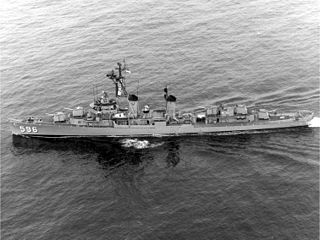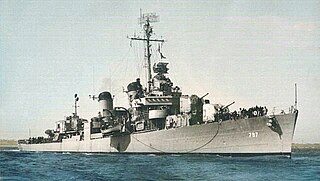
USS Collett (DD-730) was a World War II-era Allen M. Sumner-class destroyer in the service of the United States Navy.

USS McGinty (DE-365) was a John C. Butler-class destroyer escort of the United States Navy.

USS Nicholas (DD/DDE-449) was a Fletcher-class destroyer of the United States Navy, serving for a total of 27 years, including through most of World War II, the Korean War, and the Vietnam War. She was the second Navy ship to be named for Major Samuel Nicholas.

USS Wedderburn (DD-684), was a Fletcher-class destroyer of the United States Navy.

USS Taylor (DD/DDE-468) was a Fletcher-class destroyer of the United States Navy, named for Rear Admiral William Rogers Taylor (1811–1889). She was laid down on 28 August 1941 at Bath, Maine, by the Bath Iron Works Corp.; launched on 7 June 1942, sponsored by Mrs. H. A. Baldridge; and commissioned on 28 August 1942 at the Charlestown Navy Yard near Boston, Mass.

USS Tingey (DD-539) was a Fletcher-class destroyer of the United States Navy. She was the third Navy ship to be named for Commodore Thomas Tingey (1750–1829).

USS Shields (DD-596), was a Fletcher-class destroyer of the United States Navy.

USS Yarnall (DD-541), a Fletcher-class destroyer, was the second ship of the United States Navy to be named for Lieutenant John Yarnall (1786–1815).

USS Waldron (DD-699), an Allen M. Sumner-class destroyer, was the only ship of the United States Navy to be named for John C. Waldron, a U.S. Naval aviator who led a squadron of torpedo bombers in World War II.

USS Hank (DD-702), an Allen M. Sumner-class destroyer, was named for Lieutenant Commander William Hank.

USS Taussig (DD-746) was an American Allen M. Sumner-class destroyer. It was named for Edward D. Taussig, a rear admiral of the United States Navy whose career spanned over 50 years. Adm. Taussig is remembered for claiming Wake Island for the United States on January 17, 1899 while commanding the gunboat Bennington and for accepting the physical relinquishment of Guam from Spain, ending 300 years of Spanish colonial rule.

USS Blue (DD-744), an Allen M. Sumner-class destroyer, was the second United States Navy ship of that name, for Lieutenant Commander John S. Blue (1902–1942).

USS Brush (DD-745), an Allen M. Sumner-class destroyer, is the only ship of the United States Navy to be named for Charles Brush, an American inventor and philanthropist.

USS Caperton (DD-650) was a Fletcher-class destroyer of the United States Navy, named for Admiral William B. Caperton (1850–1941).

USS Cotten (DD-669) was a Fletcher-class destroyer of the United States Navy, named for Captain Lyman A. Cotten (1874–1926).

USS Cushing (DD-797) was a Fletcher-class destroyer of the United States Navy, the fourth Navy ship named for Commander William B. Cushing (1842–1874), who distinguished himself during the American Civil War. Cushing was launched on 30 September 1943, by Bethlehem Steel Co., in Staten Island, New York; she was sponsored by Miss Katherine A. Cushing, a daughter of Commander Cushing. The vessel's commissioning was on 17 January 1944.

USS Monssen (DD-798) was a Fletcher-class destroyer of the United States Navy, the second Navy ship named for Lieutenant Mons Monssen (1867–1930), who was awarded the Medal of Honor for putting out a fire in a magazine on Missouri.

USS William Seiverling (DE-441) was a John C. Butler-class destroyer escort acquired by the United States Navy during World War II. The primary purpose of the destroyer escort was to escort and protect ships in convoy, in addition to other tasks as assigned, such as patrol or radar picket. Post-war she returned home bearing four battle stars; when she was reactivated for the Korean War, she returned home after that war with three more.

USS Ulvert M. Moore (DE-442) was a John C. Butler-class destroyer escort acquired by the U.S. Navy during World War II. The primary purpose of the destroyer escort was to escort and protect ships in convoy, in addition to other tasks as assigned, such as patrol or radar picket. Post-war she returned home bearing five battle stars; when she was reactivated for the Korean War, she returned home after that war with three more.

USS Silverstein (DE-534) was a John C. Butler-class destroyer escort in service with the United States Navy from 1944 to 1947 and from 1951 to 1958. She was sold for scrapping in 1973.






















